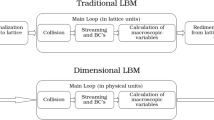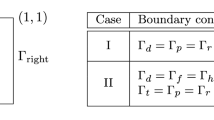Abstract
In this work, a truly explicit time-marching methodology is discussed for the time-domain solution for heat propagation considering the dual-phase-lag (DPL) bioheat model. The proposed technique considers self-adjustable time integration parameters, and it is approached together with automated calculations of domain decomposition and subcycling, providing a very versatile fully adaptive solution algorithm. The discussed domain decomposition procedure automatically divides the domain model into different subdomains (according to the properties of the discretized problem), in which different time-step values are applied, enabling more efficient (yet stable) explicit analyses. Expressions for the adaptive time integration parameters of the method and for the critical time steps of the subdomains of the model are presented and discussed. At the end of the paper, benchmark and applied examples are studied, showing the excellent performance of the proposed approach and the great effectiveness of the discussed fully adaptive formulation.





















Similar content being viewed by others
References
Minkowycz WJ, Sparrow EM, Murthy JY, Abraham JP (2007) Handbook of Numerical Heat Transfer, 2nd edn. Wiley, New Jersey
Liu J, Xu LX (2000) Boundary information based diagnostics on the thermal states of biological bodies. Int J Heat Mass Transf 43(16):2827–39
Torvi DA, Dale JD (1994) A finite element model of skin subjected to a flash fire. J Biomech Eng 116(3):250–5
Dai W, Yu H, Nassar R (2004) A fourth-order compact finite-difference scheme for solving a 1-D pennes’ bioheat transfer equation in a triple-layered skin structure. Numer Heat Transf, B: Fundam 46(5):447–61
Chan CL (1992) Boundary element method analysis for the bioheat transfer equation. J Biomech Eng 113(4):358–65
Tzou DY. A unified field approach for heat conduction from macro- to microscales. J. Heat Transfer. 1995;117.
Liu J, Chen X, Xu LX (1999) New thermal wave aspects on burn evaluation of skin subjected to instantaneous heating. IEEE Trans Biomed Eng. 46(4):420–8
Özen Ş, Helhel S, Çerezci O (2008) Heat analysis of biological tissue exposed to microwave by using thermal wave model of bio-heat transfer (TWMBT). Burns 34(1):45–49
Liu KC (2008) Thermal propagation analysis for living tissue with surface heating. Int J Therm Sci. 47(5):507–513
Xu F, Seffen KA, Lu TJ (2008) Non-Fourier analysis of skin biothermomechanics. Int J Heat Mass Transf 51(9–10):2237–2259
Loureiro FS, Wrobel LC, Mansur WJ (2012) Solution of hyperbolic bioheat transfer problems by numerical Green’s functions: the ExGA-linear θ method. J Braz Soc Mech Sci Eng 34(4):459–468
Cattaneo C (1958) A form of heat conduction equation which eliminates the paradox of instantaneous propagation. Compte Rendus. 247(4):431
Vernotte P (1961) Some possible complications in the phenomena of thermal studies. Compete Rendus 252:2190–2191
Tzou DY (2014) Macro- to microscale heat transfer: the lagging behavior, 2nd edn. John wiley & sons, New Jersey
Askarizadeh H, Ahmadikia H (2015) Analytical study on the transient heating of a two-dimensional skin tissue using parabolic and hyperbolic bioheat transfer equations. Appl Math Model 39(13):3704–20
Hobiny AD, Abbas IA (2020) Nonlinear analysis of dual-phase lag bio-heat model in living tissues induced by laser irradiation. J Therm Stress 43(4):503–511
Jasiński M, Majchrzak E, Turchan L (2016) Numerical analysis of the interactions between laser and soft tissues using generalized dual-phase lag equation. Appl Math Model 40(2):750–62
Zhang Q, Sun Y, Yang J (2021) Thermoelastic behavior of skin tissue induced by laser irradiation based on the generalized dual-phase lag model. J Therm Biol 100:103038
Zhou H, Li P, Zuo W, Fang Y (2020) Dual-phase-lag thermoelastic damping models for micro/nanobeam resonators. Appl Math Model 79:31–51
Liu L, Zheng L, Chen Y (2018) Macroscopic and microscopic anomalous diffusion in comb model with fractional dual-phase-lag model. Appl Math Model 62:629–637
Shah FA, Awana MI (2020) A computational wavelet method for solving dual-phase-lag model of bioheat transfer during hyperthermia treatment. Comput Math Methods 2(4):e1095
Kumar M, Rai KN, Rajeev. (2020) A study of fractional order dual-phase-lag bioheat transfer model. J Therm Biol 93:102661
Fahmy MA (2021) A new boundary element algorithm for a general solution of nonlinear space-time fractional dual-phase-lag bio-heat transfer problems during electromagnetic radiation. Case Stud Therm Eng. 25:100918
Hughes TJR (2000) The finite element method: linear static and dynamic finite element analysis. Dover Publications INC, New York
Zienkiewicz O, Taylor R, Zhu JZ (2013) The Finite Element Method: its Basis and Fundamentals, 7th edn. Elsevier, Amsterdam
Soares D (2021) Three novel truly-explicit time-marching procedures considering adaptive dissipation control. Eng Comput 38:3251–3268
Pinto LR, Soares D, Mansur WJ (2021) Elastodynamic wave propagation modelling in geological structures considering fully-adaptive explicit time-marching procedures. Soil Dyn Earthq Eng 150:106962
Gravouil A, Combescure A (2001) Multi-time-step explicit - implicit method for non-linear structural dynamics. Int J Numer Methods Eng 50(1):199–225
Dujardin G, Lafitte P (2016) Asymptotic behaviour of splitting schemes involving time-subcycling techniques. IMA J Numer Anal 36(4):1804–1841
Soares D, Mansur WJ, Lima DL (2007) An explicit multi-level time-step algorithm to model the propagation of interacting acoustic-elastic waves using finite element/finite difference coupled procedures. CMES Comput Model Eng Sci. 17(1):19
Hulbert GM, Chung J (1996) Explicit time integration algorithms for structural dynamics with optimal numerical dissipation. Comput Methods Appl Mech Eng. 137(2):1785–188
Noh G, Bathe KJ (2013) An explicit time integration scheme for the analysis of wave propagations. Comput Struct 129:178–193
Soares D (2021) A multi-level explicit time-marching procedure for structural dynamics and wave propagation models. Comput Methods Appl Mech Eng 375:1136
Soares D (2021) A novel single-step explicit time-marching procedure with improved dissipative, dispersive and stability properties. Comput Methods Appl Mech Eng 386:114077
Pennes HH (1998) Analysis of tissue and arterial blood temperatures in the resting human forearm. J Appl Physiol 85(1):5–34
Nazmdeh H, Vahabi M, Nazari MA (2021) Finite element modeling of Non-Fourier heat transfer in a cancerous tissue with an injected fat layer during hyperthermia treatment. J Therm Biol 100:103073
Figueiredo AAA, Nascimentodo JG, Malheiros FC, Silva Ignacioda LH, Fernandes HC, Guimaraes G (2019) Breast tumor localization using skin surface temperatures from a 2D anatomic model without knowledge of the thermophysical properties. Comput Methods Programs Biomed 172:65–77
Paruch M (2020) Mathematical modeling of breast tumor destruction using fast heating during radiofrequency ablation. Materials 13(1):136
Soares D, Wrobel LC (2018) Solution of hyperbolic bioheat conduction models based on adaptive time integrators. Finite Elem Anal Des 149:1–14
PDQ Adult Treatment Editorial Board. (2002) Breast Cancer Treatment During Pregnancy (PDQ®): Patient Version. In: PDQ Cancer Information Summaries. National Cancer Institute, US
Roetzel W, Xuan Y (1998) Transient response of the human limb to an external stimulus. Int J Heat Mass Transf 41(1):221–239
Feldmann A, Wili P, Maquer G, Zysset P (2018) The thermal conductivity of cortical and cancellous bone. Eur Cells Mater 35:25–33
Karmani S (2006) The thermal properties of bone and the effects of surgical intervention. Curr Orthop. 20(1):52–58
Liu KC, Chen HT (2009) Analysis for the dual-phase-lag bio-heat transfer during magnetic hyperthermia treatment. Int J Heat Mass Transf 52(5–6):1214–1222
Acknowledgements
The financial support by CNPq (Conselho Nacional de Desenvolvimento Científico e Tecnológico), CAPES (Coordenação de Aperfeiçoamento de Pessoal de Nível Superior), FAPEMIG (Fundação de Amparo à Pesquisa do Estado de Minas Gerais), PRH-ANP (Programa de Recursos Humanos da Agência Nacional do Petróleo, Gás Natural e Biocombustíveis) and PETROBRAS (CENPES – 21066) is greatly acknowledged.
Funding
CNPq, CAPES, FAPEMIG, PRH-ANP, Petrobras.
Author information
Authors and Affiliations
Corresponding author
Additional information
Publisher's Note
Springer Nature remains neutral with regard to jurisdictional claims in published maps and institutional affiliations.
Rights and permissions
Springer Nature or its licensor holds exclusive rights to this article under a publishing agreement with the author(s) or other rightsholder(s); author self-archiving of the accepted manuscript version of this article is solely governed by the terms of such publishing agreement and applicable law.
About this article
Cite this article
Pinto, L.R., Soares Jr., D. & Mansur, W.J. A novel fully adaptive truly explicit time-marching methodology for the solution of hyperbolic bioheat conduction models. Engineering with Computers 38, 4183–4206 (2022). https://doi.org/10.1007/s00366-022-01739-x
Received:
Accepted:
Published:
Issue Date:
DOI: https://doi.org/10.1007/s00366-022-01739-x




